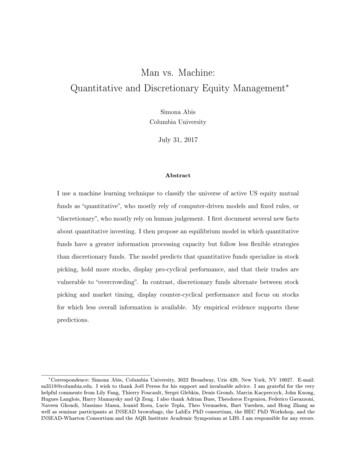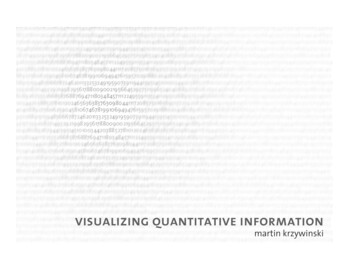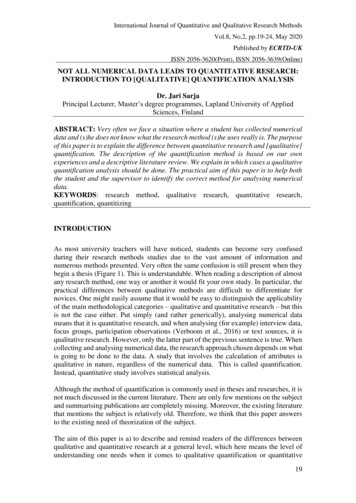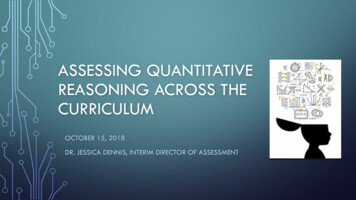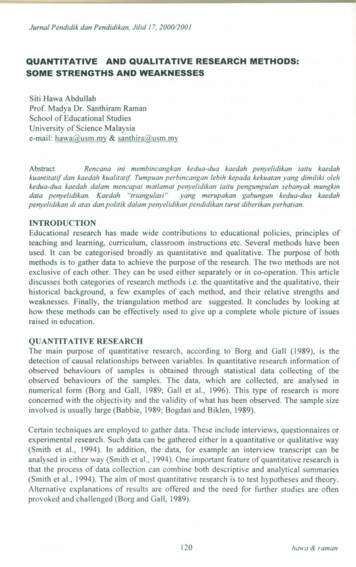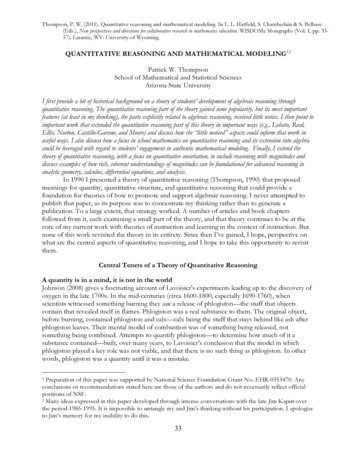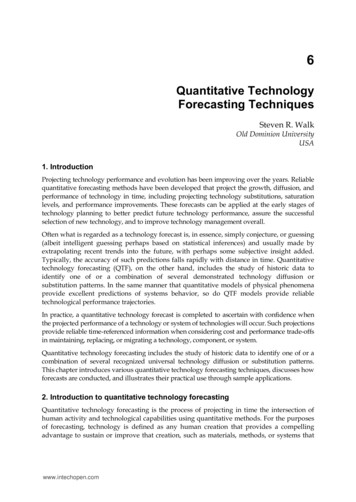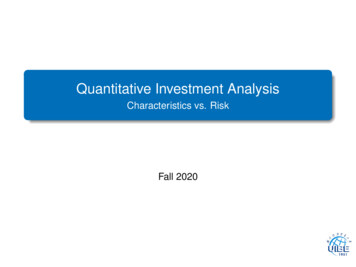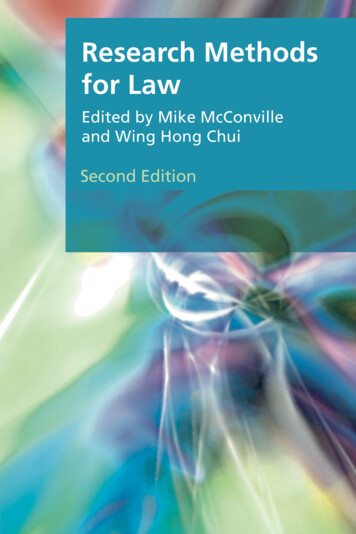
Transcription
Advances in Economics, Business and Management Research, volume 656Proceedings of the 2022 2nd International Conference on Enterprise Management and Economic Development (ICEMED 2022)Research on Quantitative Analysis Model of FinancialRisk ValueZhaowei Chen1,*Fuzhou University, School of Economics and Management, Fuzhou, China, 350000*Corresponding author: 071903227@fzu.edu.cnABSTRACTWith the continuous improvement of theoretical and practical research on financial development, especially under thecondition of further innovation of China's multi-level capital market system, there are more and more uncertain factorscausing financial risk. It is very necessary to strengthen the research on the value of financial risk. This paper studiesthe quantitative model of financial value at risk from the perspective of factor pricing model and GARCH model. Theresearch results can predict and prevent various risks in the process of financial development. The research results canalso reduce the scope and degree of losses, and provide a more accurate reference basis for the construction andempirical analysis of the financial risk value quantitative model.Keywords: Quantitative analysis; model; financial risk; value-at-risk1. INTRODUCTIONUnder the background of economic globalization, anyportfolio management is not an isolated financial activity.The objective conditions such as time difference andlocation advantage among the world financial marketsalso determine some complex relations and nonlinearcharacteristics of asset price fluctuations to a certainextent. Quantitative analysis of financial value of risk isan integrated system engineering, and its practicalapplication involves many aspects and stages. Only bycarrying out complete macro-control of each stage, canfinancial risks be controlled more accurately and theactual effect of quantitative value of risk of financial canbe brought into full play. Risk measurement plays animportant role in financial risk management. It mainlyrelies on quantitative analysis method to measure thepossibility of loss caused by various risks and the scopeand degree of loss, so as to provide reliable quantitativebasis for risk management.The quantification of financial value of risk involvesthe basic theoretical knowledge of finance, theoreticaleconometrics, investment and other related disciplines,and relevant scholars have carried out certain research. Itis pointed out that modeling the historical return of anasset as a univariate Generalized AutoregressiveConditional Heteroscedasticity (GARCH) process isoften used as a basis for price discovery in illiquidderivatives markets. Heston's model is often used becauseit has a convenient closed-form solution. However, thisgenerally applies to spot price dynamics. Therefore,subsequent scholars carried out a series of studies on thebasis of Heston's model to supplement the shortcomingsof the model [1]. Yang K et al fitted and analyzed theHFT data of Vanke A (000002) based on GARCH modeland its derivative model [2]. Zolfaghari M et al predictedstock indexes by applying a hybrid model combiningAdaptive Wavelet Transform (AWT), Long and ShortTerm Memory (LSTM) and ARIMAX-GARCH seriesmodels [3]. Venter P-J et al compared the model pricewith the market price to show the pricing performance,and studied the application of single-variable and multivariable GARCH model in the pricing of bitcoin futuresand options [4]. Wang X-C evaluated the options with themaximum or minimum of the two prices under theGARCH model [5].It is particularly important to study the quantitativeanalysis model of financial risk value in the great era ofthe rise of China's financial industry. In the backdrop ofthe discipline overlapping, this study of factor pricingmodel, GARCH model, such as financial econometricsmodel analysis, from the Angle of multi-scale analysisand Bayesian learning, the Value-at-Risk (VaR) model offinancial risk management is expanding in some relevanttheory, and then found some new financial riskquantification and portfolio management theory angle ofview and practical experience.Copyright 2022 The Authors. Published by Atlantis Press International B.V.This is an open access article distributed under the CC BY-NC 4.0 license -http://creativecommons.org/licenses/by-nc/4.0/.10
Advances in Economics, Business and Management Research, volume 6562. FACTOR PRICING MODELCapital Asset Pricing Model (CAPM) shows that therisk premium of a single asset is equal to the β times ofthe market risk premium, which measures the degree ofcovariance between the return of a single asset and thereturn of the market portfolio. Factor pricing model is thetheoretical generalization of the capital asset pricingmodel, by means of wavelet multi-resolution analysis tostudy the effect of risk factors for a single asset price thevalue of the portfolio risk analysis is a very meaningfulwork, financial globalization has made a single asset andportfolio risk is affected by more factors, such as marketrisk, interest rate risk, exchange rate risk, etc.2.1. Double Factor Pricing ModelTaking market risk and exchange rate risk as riskfactors, this paper studies the double factor pricing modelbased on wavelet multi-resolution analysis and itsapplication in portfolio value at risk measurement. In thedouble factor pricing model, the market risk is measuredby the return of the market composite index, and theexchange rate risk is measured by the return of theexchange rate. Letri (i 1, 2,3,, m) represent returnE (ri r ) ( E (rw ) r )( E ( s) r )cov(ri , rw ) cov(ri , s)Var (rw )Var ( s)(5)That is, the following Formula (6) :E(ri r ) 1i ( E(rw ) r ) 2i ( E(s) r )In Formula (6), 1iand 2i(6)are the sensitivity of asingle asset I to market risk factors and exchange rate riskfactors. Combined with equations (5) and (6), theexpressions of 1i and 2i are as follows: 1i cov(ri , rw ) / Var (rw ) 2i cov(ri , s) / Var ( s)(7)The above Formulas (5) and (6) are the double factorpricing model including market risk factor and exchangerate risk factor.2.2. Multi-Factor Pricing ModelThe effective pricing of assets has always been thecore problem in finance, and the exact relationshipbetween asset return and risk is the different expressionof this problem. On the basis of the double factor pricingmodel, related scholars also developed the multi-factorpricing model.rx represent return on portfolio, and portfolioX ( x1 , x2 , x3 xm ) . rw representsweight vector is market index yield, s is exchange rate yield. 1 and 2Fama proposed a three-factor model, which furtherclarified the relationship between excess return on assetsand risk factors in 1993. Fama won the 2013 Nobel Prizein Economics for his outstanding contributions to assetpricing theory. Since then, many scholars have followedrepresent the covariance risk sensitivity of return onto explore the applicability of the traditional pricingassets to risk factors, so the expected risk premium ofmodel in different capital markets and come to differentassets is [6]:conclusions. It should be noted that the traditional assetpricing theory assumes that the distribution of asset return(1)E(ri r ) 1 cov(ri , rw ) 2 cov(ri , s)follows a normal distribution, which is inconsistent withIn Formula (1), the expected risk premium of visiblethe actual data. In many literatures, it is found that theassets is composed of market risk and exchange rate riskcharacteristics of return on financial assets arepremium. The first item is similar to the market systeminconsistent at different frequencies, so different modelsrisk premium of CAPM model, and the second itemneed to be built to describe the characteristics of real data.indicates that investors are concerned about the exchangeFor example, Z-B Li et al. analyzed the Sinicization ofrate risk premium of asset returns. By substituting theFF5 model with 21 years' monthly data of China's Areturn rate sequence of the two risk factors into Equationshare market as samples. After analyzing different(1), equations (2) and (3) can be obtained, and 1 , 2samples in different periods, they found that the fiveare obtained by further solving:factor model had stronger explanatory ability than theE(rw ) r 1 cov(rw , rw ) 2 cov(rw , s) 1Var (rw ) 2 cov(rw , s) single-factor model, three-factor model and four-factormodel [7]. In the framework of FF5 model analysis, W(2)W Du improved the construction method of HML factorE(s) r 1 cov(s, rw ) 2 cov(s, s) 1 cov(s, rw ) 2Var (s)and established a multi-factor pricing model more in line(3)with market characteristics [8]. L. Wang introduced GCForest algorithm on the basis of multi-factor model toAccording to cov(rw , s) 0 , this paper gets:explore stock selection strategies and excess returns inthe stock market. Through empirical analysis and 1 ( E (rw ) r ) / Var (rw )(4) research comparison, L. Wang found that in the robust 2 ( E ( s) r ) / Var ( s)trend of CSI 300 index, and Gc Forest strategy has aCombining (4) with (1), a double factor asset pricingbetter effect in controlling the prediction of retracting [9].model is obtained as follows:It is found that the idiosyncratic volatility is anindependent risk factor that needs to be priced, which canon assets,11
Advances in Economics, Business and Management Research, volume 656describe the return characteristics of stocks to a certainextent and improve the explanatory power of the model.2.3. Application of Factor Pricing Modelgrowth rate may decline in the future, so that the returnrate of the whole process meets the expectation.Therefore, this stock should not be bought in the future,on the contrary, it should be bought, Similarly, we shouldbe aware that such methods are not absolute.2.3.1. Factor to pick stocks3. GARCH MODELThe factor pricing model is often used in the stockmarket for stock selection. Its main step is to include thefactors that may affect or explain the expected rate ofreturn of stocks into the model. Generally, the commonlyused factors include the size of listed companies, assetliability ratio, roe, ROA, etc. at the same time, selectappropriate stock data and analyze them withmeasurement methods. Firstly, filtering the factors andusing the effective factors is helpful for the next analysis,such as FF three factor model. The factor selected by themodel - the market value of listed companies. Throughthe model analysis, it is found that the expected return onassets of listed companies with small market value isrelatively high, so they should sell the stocks of listedcompanies with small market value in order to obtainexcess returns. In addition to selecting the underlyingstocks, in recent years, investors have used the multifactor model to predict the buying, rising and fallingtimes of stocks, and its steps are roughly similar to thestock selection steps.2.3.2. HedgingThe factor pricing model can also be used to hedgerisks, mainly in tracking various Index ETF funds. Theassets that can be traded in these markets have uniqueadvantages as factors. Its operating principle is mainlyseparation. It can be inferred from Formula (5) that theintercept term should be 0, but if the intercept term is not0 and positive for some reasons, The corresponding partcan be sold by buying assets, which will be separated bythis method. Because the return difference between assetsand asset portfolio is very small, the two prices will berelatively close. So the cost of holding a portfolio shortand an asset long at the same time will be very small.From the perspective of market microstructure,traders always put their own interests first, hoping tomaximize the economic profits of enterprises through thelowest capital cost. In the field of behavioral finance, thispaper makes an in-depth analysis of traders' behavior,combines various types of traders' investment behavior,observes the local fluctuation characteristics in theirdevelopment process, and establishes GARCH model onthis basis, which can not only show the analytical role ofthe original model, but also expand the original model. Itcan capture the impact of transaction informationcontained in different transaction cycles on the volatilityof asset return.3.1. Basic GARCH ModelWhen constructing the GARCH model, this papershould take into account the multi cycle trading behaviorof investors, clarify the asset price formation mechanismcontained in the multi cycle trading behavior, put forwardthe GARCH model from the perspective of waveletmulti-scale analysis, optimize and prove the GARCHmodel according to the reasonable regulation of relevantdata, and verify the statistical characteristics on the basisof comprehensive index return, further ensure theauthenticity and reliability of GARCH model, andprovide a basic guarantee for the quantitative analysis offinancial value at risk. The expression of the basicGARCH model is:rt t t t t Zt 2 w r 2 2t 1t 1 tIn Formula (8),2.3.3. Statistical arbitrageandStatistical arbitrage is different from arbitrage.Statistical arbitrage realized by multi factor model refersto using statistical analysis tools to find out the long-termstable quantitative relationship between interrelated assetprices. If asset prices change and deviate from this longterm stable relationship in the actual process,corresponding operations can be carried out to predictthat this deviation will disappear. Therefore, thisstatistical arbitrage method is risky. The operation step ofstatistical arbitrage is to calculate the return rate of eachstock in the past period. If the actual return rate of a stockexceeds the expected return rate, it can be judged that thestock is growing too fast during this period, and theand t(8)represents the expected return t is the residual term, that is, the nonprofitable itemzt is the nonprofitable item index and w is a2constant term and rt 1 is the ARCH term, and uses thelag of the square of the perturbation term of the meanequation to measure the information of volatility obtainedfrom the previous period and t2 1 is the predictionvariance of the previous period, representing GARCHterm.With the help of GARCH model, this paper makes aquantitative analysis of financial value at risk, furtherdefines the important role of value at risk in financialdevelopment, and summarizes the corresponding12
Advances in Economics, Business and Management Research, volume 656statistical description test characteristics. The standarddeviation of GARCH model will change with the changeof scale. The larger the scale, the value of standarddeviation will increase. In other words, investors facedifferent investment risks within a certain range. Ifinvestors want to ensure their economic benefits, theymust formulate corresponding development strategiesfrom different time scales. Moreover, the statisticaldescription skewness of different scales will also changewith the change of return. Generally, the peak of eachscale is greater than three, and is positively correlatedwith the scale. The peak characteristics of the distributionof Shanghai stock index return in the sample periodchange significantly with the scale.3.2. Multivariate GARCH ModelIn the financial market, great progress has been madein the research of its volatility, but there are a variety ofassets in the financial market. When making financialasset portfolio investment, it will face the problems ofmultiple assets, multiple profits and multiple risks. At thesame time, in the context of economic globalization, thefinancial markets of various countries are interrelated andaffect each other. The study of the linkage between thestock markets not only has great reference significancefor individual investors and institutional investors in riskmanagement, but also has great reference value for thegovernment in financial supervision and the formulationof stock market policies. In view of this, many scholarshave improved and expanded on the basis of GARCHmodel and formed a series of multivariate GARCHmodels [10]. The CCC- GARCH model is formulated asfollows [11]: t Dt RDt(9)In Formula (9), R is the constant correlation matrixof ϵ j, Tj (estimated using historical data). The diagonalmatrix Dt takes the following form: h1 , t 0 0 (10) 0 Dt 0hN , t The conditional variance of each asset is assumed tobe consistent with Equation (11).An obvious shortcoming of the CCC-GARCH modelis the assumption of constant correlation. To address thisproblem, Engle extended the model to incorporatedynamic conditional correlation (DCC). The DCCGARCH model is formulated as follows: t Dt Rt DtIn Formula (11),(11) 1Rt diag (Qt ) 2 Qt diag (Qt )In Formula (11), 12(12)diag is the diagonal matrix symbol,Qt is modelled using an autoregressive process:Qt (1 1 2 )Q 2Qt 1(13)It can be seen that the estimation of CCC-GARCHmodel is mainly divided into two steps: the first step is toestimate the conditional variance Dt of a single asset byequation (10) The second step is to estimate thecorrelation matrix R of multidimensional assetsaccording to equation (12), and then obtain its dynamiccovariance matrix Qt according to equation (13). ForCCC-GARCH model, the conditional variance of a singleasset is estimated by univariate GARCH model, which isrelatively simple to estimate however, for the correlationmatrix R, when the asset dimension considered is highand the amount of data is large, its estimation becomesmore difficult.4. CONCLUSIONIt can be seen from the above analysis that it is of greatsignificance to construct a more perfect valuequantification model on the basis of Value-at-Risk.Mathematical modeling is carried out from theperspective of factor pricing model and GARCH model,including analysis of four models including double-factorpricing model, multi-factor pricing model, basic GARCHmodel and multi-CCC-GARCH model, to further clarifythe important role of value-at-risk in financialmanagement and financial development. The calculationmethod of financial risk management tool is extended,which can provide a certain reference for the similarresearch of quantitative analysis model of financial riskvalue.AUTHORS’ CONTRIBUTIONSThis paper is independently completed by ZhaoweiChen.ACKNOWLEDGMENTSI acknowledges the valuable collaboration ofHonigsberg and Zhibing Lin.REFERENCES[1] S. L. Heston & N. Saikat, A closed-form GARCHoption valuation model [J] The Review of FinancialStudies, vol. 13, 2000, pp. 585–625.[2] K. Yang & X-Y Yu, Quantitative and price analysisof high-frequency financial data based on GARCHmodels[J]JournalofJilinNormal13
Advances in Economics, Business and Management Research, volume 656University(Natural Science Edition), vol. 34, no. 4,2021, pp. 26-30.[3] M. Zolfaghari & S. Gholami, A hybrid approach ofadaptive wavelet transform, long short-termmemory and ARIMA-GARCH family models forthe stock index prediction [J] Expert Systems withApplications, vol. 182, 2021, pp. 115149.[4] P. J. Venter & E. Maré, Univariate and MultivariateGARCH Models Applied to Bitcoin Futures OptionPricing [J] Journal of Risk and FinancialManagement, vol. 14, no. 6, 2021, pp. 261.[5] X. C. Wang, Valuation of options on the maximum oftwo prices with default risk under GARCH models[J] The North American Journal of Economics andFinance, vol. 57, 2021, pp. 101422.[6] Q. Fu & X. H. Peng, Research on multi-resolutioncharacteristics of Portfolio VaR Based on two factorpricing model [J] Journal of Mathematics in Practiceand Theory, vol. 40, no. 22, 2010, pp. 10-25.[7] Z. B. Li & G.Y. Yang & Y. C. Feng, Fama-FrenchFive Factor Model in China Stock Market [J]Journal of Financial Research, vol. 6, 2017, pp. 191206.[8] W. W. Du & S. G. Xiao, Research on theImprovement of Fama-French Five-Factor Model inChina Stock Market [J] Journal of HuaqiaoUniversity (Philosophy & Social Sciences), vol. 3,2018, pp. 39-53.[9] L. Wang & L. Li, Multi-factor Ouantitative StockSelection Strategy Based on gc Forest [J] ComputerEngineering and Applications, vol. 56, no. 15, 2020,pp. 86-91.[10] A. Jalan & M. Roman & A. Saqib, The Bitcoinoptions market: A first look at pricing and risk [J]Applied Economics, vol.53, 2020, pp. 1–16.[11] B Abdelouahab & K Karima, Whittle estimation inmultivariate CCC - GARCH processes [J]Communications in Statistics - Theory andMethods, vol. 48, 2019, pp. 3921–3940.14
study the effect of risk factors for a single asset price the value of the portfolio risk analysis is a very meaningful work, financial globalization has made a single asset and portfolio risk is affected by more factors, such as market risk, interest rate risk, exchange rate risk, etc. ii 2.1. Double Factor Pricing Model
